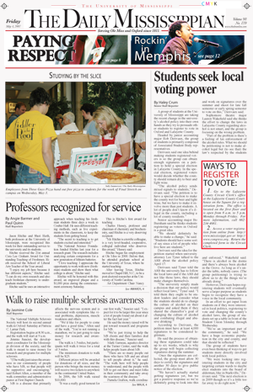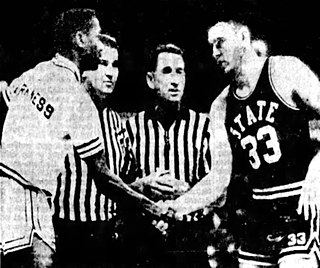
James Howard Meredith is an American civil rights activist, writer, political adviser, and United States Air Force veteran who became, in 1962, the first African-American student admitted to the racially segregated University of Mississippi after the intervention of the federal government. Inspired by President John F. Kennedy's inaugural address, Meredith decided to exercise his constitutional rights and apply to the University of Mississippi. His goal was to put pressure on the Kennedy administration to enforce civil rights for African Americans. The admission of Meredith ignited the Ole Miss riot of 1962 where Meredith's life was threatened and 31,000 American servicemen were required to quell the violence – the largest ever invocation of the Insurrection Act of 1807.

Starkville is a city in, and the county seat of, Oktibbeha County, Mississippi, United States. Mississippi State University is a land-grant institution and is located partially in Starkville but primarily in an adjacent unincorporated area designated by the United States Census Bureau as Mississippi State, Mississippi. The population was 25,653 in 2019. Starkville is the most populous city of the Golden Triangle region of Mississippi. The Starkville micropolitan statistical area includes all of Oktibbeha County.

Mississippi State University for Agriculture and Applied Science, commonly known as Mississippi State University (MSU), is a public land-grant research university adjacent to Starkville, Mississippi. It is classified among "R1: Doctoral Universities – Very High Research Activity" and has a total research and development budget of $239.4 million, the largest in Mississippi.

Wiley University is a private historically black college in Marshall, Texas. Founded in 1873 by the Methodist Episcopal Church's Bishop Isaac Wiley and certified in 1882 by the Freedman's Aid Society, it is one of the oldest predominantly black colleges west of the Mississippi River.

The University of North Alabama (UNA) is a public university in Florence, Alabama. It is the state's oldest public university. Occupying a 130-acre (0.5 km2) campus in a residential section of Florence, UNA is located within a four-city area that also includes Tuscumbia, Sheffield and Muscle Shoals. The four cities compose a metropolitan area with a combined population of 140,000 people.

Oakwood University is a private, historically black Seventh-day Adventist university in Huntsville, Alabama. It is the only HBCU owned and operated by the Seventh-day Adventist Church.

Vivian Juanita Malone Jones was one of the first two black students to enroll at the University of Alabama in 1963, and in 1965 became the university's first black graduate. She was made famous when George Wallace, the Governor of Alabama, attempted to block her and James Hood from enrolling at the all-white university.

James Harrison "Babe" McCarthy, was an American professional and collegiate basketball coach. McCarthy was originally from Baldwyn, Mississippi. McCarthy may best be remembered for Mississippi State's appearance in the 1963 NCAA Men's Division I Basketball Tournament when his all-white team sneaked out of town in order to face Loyola University Chicago, which had four black starters.

Dean Wallace Colvard was a president of Mississippi State University, notable for his role in a 1963 controversy surrounding the participation of the university's basketball team in the NCAA tournament.

The Daily Mississippian, commonly called The DM, is the student newspaper of the University of Mississippi. The first issue of The Mississippian was published in 1911. It is operated as an independent student-run newspaper, and is published in print one day a week and online daily. It publishes Thursdays during the fall and spring semesters, and occasionally during the June and July summer terms. It has a daily print circulation of 9,000 during fall and spring. It is also the only college newspaper in Mississippi to be a full member of the state press association, and it competes in the Mississippi Press Association's Better Newspaper Contest against professional daily newspapers.

Starkville High School (SHS) is a public secondary school in Starkville, Mississippi, United States. It is the only high school in the Starkville Oktibbeha Consolidated School District, serving grades 9–12. It offers more than 140 courses, including over 10 Advanced Placement courses. Its school colors are black and gold, and its mascot is the Yellowjacket, a predatory wasp.
Raylawni Branch is a black Mississippi pioneer of the Civil Rights Movement, a professional nursing educator and US Air Force Reserve officer. She is best known for her leading role in the integration of the University of Southern Mississippi (Hattiesburg) in 1965, which was peaceful as opposed to the violent riot triggered by white racism after the enrollment of James Meredith at the University of Mississippi (Oxford) in 1962.
Gwendolyn Elaine Armstrong was a black Mississippi pioneer in the Civil Rights Movement. In September, 1965, she and Raylawni Branch, both local natives, integrated the University of Southern Mississippi at Hattiesburg. They thus completed the process of breaking the segregation barriers at Mississippi's universities which had been begun by Clyde Kennard at (then) Mississippi Southern College (1956–61) and carried forward by James Meredith at the University of Mississippi and Richard Holmes at Mississippi State University.

The Ole Miss riot of 1962, also known as the Battle of Oxford, was a violent disturbance that occurred at the University of Mississippi—commonly called Ole Miss—in Oxford, Mississippi. Segregationist rioters sought to prevent the enrollment of African American veteran James Meredith, and President John F. Kennedy was forced to quell the riot by mobilizing over 30,000 troops, the most for a single disturbance in American history.

Bully is the official mascot of the Mississippi State University Bulldogs in Starkville, Mississippi, and the name is given to both the costumed mascot and the live bulldog that appears at State games. The live mascot Bully is an American Kennel Club registered English Bulldog, and each dog is given the inherited title of "Bully". The name "Bully" is traditionally considered a title and not the official name of the specific dog that holds it.
Donald W. Zacharias was the 15th President of Mississippi State University from 1985 to 1997. He died of complications of multiple sclerosis on March 3, 2013, at 77 years of age. Previously he served as the 6th president of Western Kentucky University from 1979 until 1985.

In the United States, school integration is the process of ending race-based segregation within American public and private schools. Racial segregation in schools existed throughout most of American history and remains an issue in contemporary education. During the Civil Rights Movement school integration became a priority, but since then de facto segregation has again become prevalent.
This is a timeline of the civil rights movement in the United States, a nonviolent mid-20th century freedom movement to gain legal equality and the enforcement of constitutional rights for people of color. The goals of the movement included securing equal protection under the law, ending legally institutionalized racial discrimination, and gaining equal access to public facilities, education reform, fair housing, and the ability to vote.
Henderson High School was a public secondary school in Starkville, Mississippi. United States. It served as the high school for black students until the public schools were integrated in 1970. Grades k–8 were also located on the same property. After integration, the buildings served as a junior high school and later as an elementary school.

The Game of Change was a college basketball game played between the Loyola Ramblers and the Mississippi State Bulldogs on March 15, 1963, during the second round of the 1963 NCAA University Division basketball tournament, at Jenison Fieldhouse in East Lansing, Michigan. Taking place in the midst of the American civil rights movement, the game between the racially integrated Loyola team and the all-white Mississippi State team is remembered as a milestone in the desegregation of college basketball.

















